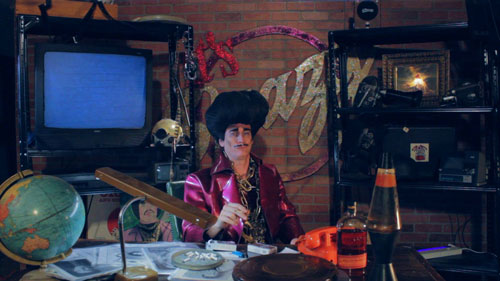Members Only
Pondering the surprising number of musical acts that have official members that don’t actually play an instrument or sing. You know, like Coldplay.
Sponsored By … You?
If you find weird or unusual topics like this super-fascinating, the best way to tell us is to give us a nod on Ko-Fi. It helps ensure that we can keep this machine moving, support outside writers, and bring on the tools to support our writing. (Also it’s heartening when someone chips in.)
We accept advertising, too! Check out this page to learn more.
“Eagle-eyed readers of the band’s album sleevenotes (or, indeed, their MySpace page) will have noted that Coldplay officially have five members—with the mysterious Mr. Phil Harvey making up the quintet. The band would, we’re told, be enormously grateful if these inaccuracies could be corrected, so that they don’t keep having to answer questions about them.”
— A 2008 post on the band’s website, making the case that Phil Harvey should be listed as a member of Coldplay on its Wikipedia page, despite the fact that he doesn’t actually play any instruments. The announcement was unusual for a band of its stature, but reflects a long history of celebrities calling out errors in their Wikipedia pages—a move that’s necessary as subjects are not supposed to edit their own pages due to a ban on using primary sources. It’s not as good as Philip Roth’s New Yorker open letter about The Human Stain (RIP), but it’s up there.

(via Coldplay’s Twitter page)
Not even Phil Harvey is completely sure why he’s considered a member of Coldplay
If nothing else, Phil Harvey has earned his stripes as a member of Coldplay, even if he didn’t necessarily play on any of the songs.
As “Fifth Beatles” go in the world of Coldplay, he’s less Pete Best and more Brian Epstein, perhaps with a sprinkling of George Martin.
Harvey was there at the beginning, when the band was forming during their college years, as students at University College London.
A childhood friend of band founder Chris Martin, Harvey signed on as the band’s manager in the early years, and helped the band wend its way through the complexities of modern success, which didn’t come overnight. He did the hard work that led up to “Yellow” suddenly showing up everywhere one day.
But there was a problem: It eventually became obvious that the band was going to be closer to U2 in popularity than, say, Travis. (Editor’s note: I think Travis—best known for this song—is the better band, but don’t tell Chris Martin I said that.)
This meant that the approach of having their pal manage everything was going to be unsustainable, not when it was clear they had a career of stadium tours and bajillion-selling albums ahead of them. And Harvey, with the weight of all this stuff on this shoulders, had a breakdown and quit managing the band just as it was starting to peak in 2001. At age 24, he had been put through the wringer as his mates were taking over the world.
“I was feeling like death when I should have been on top of the world,” Harvey wrote of the experience at the time in a band newsletter. “I certainly thought about giving up then. It crossed my mind that I simply wasn’t tough enough.”
Eventually, he found his way back to the band, but not before spending time working on himself, earning a psychology degree and spending time volunteering with a nonprofit.
But the cycle for Coldplay’s hugely popular third album, X&Y, highlighted some divisions in the band caused by all that too-much-too-fast growth, and soon enough, Martin was calling up his mate in an effort to get to a back-to-basics approach.
“We also had to get Phil Harvey back. Phil is like our fifth member: for years he was our manager and sort of creative director,” Martin said in a 2008 interview with The Telegraph. “He left when we got too big for one person to manage, but he’s back.”
He’s been with them ever since.
Harvey didn’t come back as a manager, however, but instead as a jack of all trades, the guy who helps with whatever creative elements need to be done—including aiding with creative elements on music videos and setting up the show, which is more interactive than you’d expect.
In a recent interview with Music Business Worldwide, he pushed back on the idea of being called a creative director, saying “it makes me sound like I run a ballet company or a marketing agency.” Instead, he explained his job like this:
I am in the studio with them all day every day, but then I don’t play any instruments, so… yeah, it’s hard to explain why or indeed if I’m of any use whatsoever!
I think over the years I’ve learned to be useful: I’ve learned how to design a live show; I’ve learned to make videos; I’ve learned how to A&R. I just sort of fill in the gaps.
Dave Holmes, the band’s manager, said he fully felt that Harvey had earned his place in the band.
“I see Phil as another member of Coldplay, I really do; I manage a five piece band,” Holmes said.
Maybe Harvey is, in practice, more an Easter egg for observant fans—will he show up on Twitter one day, or write a joke at another band’s expense, or appear in one of the band’s music videos? Or maybe the band will decide one night to sing Happy Birthday to their fifth member?
If the rest of the band thinks he’s important enough to be on their Wikipedia page, who are we to judge? It’s their band, and clearly Harvey has earned a place in their hearts.
1994
The year the Grateful Dead was inducted into the Rock & Roll Hall of Fame. Among the members of the band inducted is Robert Hunter, the band’s primary lyricist and a close confidante of Jerry Garcia. (Electronic Frontier Foundation cofounder John Perry Barlow, another well-known Dead lyricist, was not made an official band member.) Like the band as a whole, Hunter had a close early association with Ken Kesey and wrote his first lyrics while on LSD. Hunter is the only non-performing individual to officially be inducted into the Rock Hall as part of a band.

Gwar’s Sleazy P. Martini, a.k.a. visual artist Don Drakulich. (via Sleazy’s Facebook page)
Five band members that don’t actually play a standard musical instrument
- King Crimson’s Peter Sinfield, a noteworthy lyricist who wrote many of the words for the band’s first four albums, played a key creative role for the band during its early years, including running its light show and making decisions regarding its artwork and visual style. Eventually Robert Fripp fell out of love with Sinfeld’s lyrical style, however, and he was replaced by Richard Palmer-James, a lyricist who wasn’t an official band member. As for Sinfield, he later worked with Emerson, Lake & Palmer.
- Jamie Hewlett, creator of Tank Girl and the visual mind behind Gorillaz, may not play any instruments (generally Damon Albarn and a rotating cast of musicians handle that part), nonetheless carries much of the water for the band, which, of course, is all about the imagery.
- The Happy Mondays’ Mark “Bez” Berry has long been a fundamental part of the Madchester band’s overall style and vibe, though outside of the occasional percussion (generally maracas), his role mostly involves dancing and serving as something of the band’s mascot. (He, of course, later became a reality TV star.)
- Ben Carr of the Mighty Mighty Bosstones, the famed ska band’s longtime dancer, has been skanking with the band basically since it started in 1983, which seems like a surprisingly long time, even by the standards of long-running ska bands. Vice’s Noisey site did a very excited interview with him a few years ago.
- Don Drakulich of Gwar, a.k.a. Sleazy P. Martini, performs as the band’s manager on stage (or, more recently, is featured in videos during performances), but has also played a significant role in forging the band’s distinctive visual look over the past 30+ years, and as a result, even if he’s not wielding an instrument, he’s a major part of the band. And with the passing of band leader Dave Brockie (a.k.a. Oderus Urungus) in 2014, he’s the guy who has the longest history with the band, though much of it was spent behind the scenes.
“Initially, it was just, ‘Look at that loaded guy up there.’ I could just look good and feel good. I kind of saw it as performance art. But, as I got older, I started to feel like I needed to learn the craft more and become a proper percussionist.”
— Joel Gion, the longtime tambourine and maracas player for the Brian Jonestown Massacre, discussing with The Guardian his standing-around-and-dancing-and-shaking-a-tambourine routine, as well as how it’s evolved over the near quarter-century he has been with the band. His role, similar to that of the Happy Mondays’ Bez, has actually proven one of the strongest constants in the notably volatile band, which was the subject of the famed documentary Dig! in 2004.
The strange thing about Phil Harvey’s somewhat unique situation with Coldplay is that the odds of it becoming more common are actually increasing.
Here’s why: Being a musician, especially one focused on the pop charts as Coldplay is, often means needing a creative mind in the artist’s corner.
A good example of this is the long-running partnership between Macklemore and producer Ryan Lewis, currently on hiatus. While Lewis actually did play a sizable musical role in the act, a significant part of his role involved visuals—which makes sense because the two met during a photo shoot. Lewis became a key collaborator with Macklemore through imagery, and that soon bled into the juggernaut that was The Heist.
Often, though, the creative director doesn’t get nearly that level of billing, even if there’s a close association. But the association is often enough. Virgil Abloh, who has served as Kanye West’s creative director for more than a decade, has earned himself enough fashion-world credibility that he’s the subject of GQ profiles himself. Abloh has a long history with Kanye, meeting him in 2003, not long before West broke through, and their relationship, which started in merchandise, soon became much deeper and more significant. Whatever your feelings about West, it’s fair to say he has some of the most interesting visual sense of any mainstream artist. And that’s in no small part due to the influence of Abloh.
You can see the influence of this heavy focus on visuals in up-and-coming acts. The hip-hop collective and self-described boy band Brockhampton (which, full disclosure, has faced a significant scandal in recent weeks) has a webmaster and a graphic designer on its long list of members. (Those members, notably, met in a Kanye West fan forum.)
In an age where visuals are everything—and said visuals are getting more sophisticated—we’re simply going to see more of this.
Two decades ago, nearly every band had four or five members, and their buddy who didn’t play an instrument ended up the manager, and their other buddy who didn’t want to go on stage ended up the producer.
But in 2018, the game is different. Bands aren’t following the same script. The future of artistry is that we’re going to have more multimedia, interactive experiences, where creative stuff is going to be hitting us a thousand ways from Tuesday. And every artist, from Kanye on down, is going to want that creative flexibility.
So as a result—dare I say it—Coldplay might be a trailblazer on the use of creative directors in bands.
If you wanna be a member of a popular band, you might as well ask, ’cause nothing’s stopping you. Not even musical talent.
:format(jpeg)/2018/06/tedium062818.gif)
/2018/06/tedium062818.gif)


/uploads/ernie_crop.jpg)